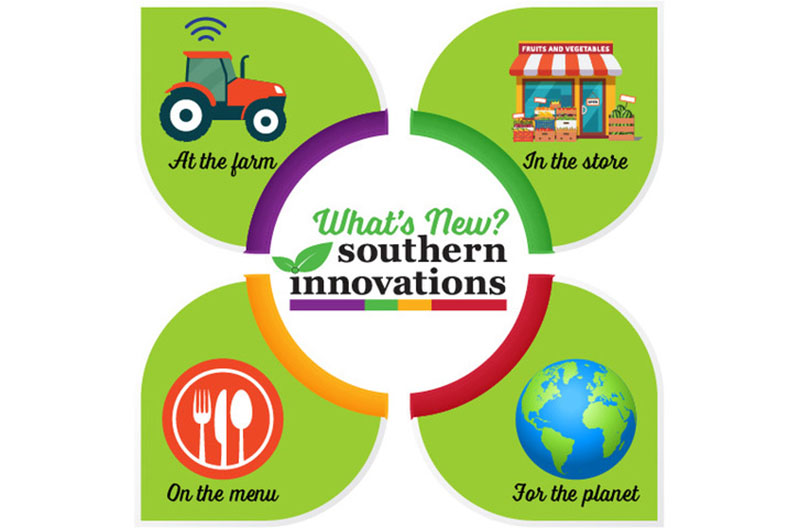The Southeast Produce Council released “What’s New? From the Consumer View 2022″ in one of two educational sessions at its fall show, Southern Innovations, on Sept. 23.
“Only 12 percent of consumers meet the daily recommended amount of fresh produce,” said David Sherrod, president and CEO. “That means there is a lot of room for growth…Exhibitors were encouraged to highlight innovations in each section and What’s New? Silent Theater presentations took place throughout the exhibit hours by pioneering organizations.
Top findings for each of the four sections of the research are:
At the farm
Seventy-four percent of consumers are unaware of how growers use technology, but four in 10 are interested in virtual field, farm or greenhouse visits. Additionally, half of consumers like the idea of mini greenhouses in-store or in the restaurant. This is driven by 55 percent of consumers wanting to know more about how the fresh produce they buy is grown.
Top ways to communicate, according to consumers, are the package label, information on the brand’s website or app and in-store signage.
In the store
Serving size education draws universal interest, among 50 percent of consumers and 42 percent like the idea of their grocery store offering personalized nutrition programs. In addition to portion size guidance, consumers want to see nutrition information, specific health benefits, origin and preparation/storage instructions.
Promotions remain very important, with in-store signage, apps and the digital circular having replaced the paper ad as the top research area. Routine meals are out and consumers look to a variety of sources for recipe and meal ideas, including high interest for shoppable recipes.
On the menu
The high level of inflation is pressuring restaurant trips and prompting 52 percent of consumers to change their orders when buying from restaurants, whether takeout, delivery or eating on premise. Sixty percent look for cheaper items on the menu, 54 percent skip desserts, 44 percent skip appetizers and 44 percent go to a cheaper restaurant altogether.
“The study also found consumer interest in crossing over trends seen in retail onto restaurant menus,” Sherrod said. “Seasonal and local fruit and vegetables are the top areas of interest in retail and also lead the list of desired menu attributes for foodservice.”
In today’s inflationary environment, 49 percent of consumers feel the best cost and quality should be a restaurant’s priority – overriding the origin, including global sourcing. Consumer agreement on restaurants using fresh produce versus frozen or canned is much higher at 72 percent.
The use of technology for ordering and paying for food in restaurants is becoming much more accepted, but the idea of robots bringing out the food instead of a server is all but a slam dunk with consumers: 31 percent simply cannot imagine the concept and 26 percent say they couldn’t stand the idea.
For the planet
Four in 10 Americans struggle with fruit and vegetables going bad before they could eat them and 91 percent end up throwing some fresh produce away. Additionally, 37 percent struggle with fresh produce being sold in packages that are too big for their households.
Consumers say commitments regarding limiting food and package waste, giving back to the community and supporting special causes are important and can influence purchases among a little more than half.
“In reality, virtually every produce brand and every retailer has sustainability commitments in place,” Sherrod said. “However, consumers aren’t aware. We have an opportunity to do good and build positive sentiment among consumers at the same time.”
The online study among 1,500 consumers was conducted and presented by 210 Analytics. The study was fielded in July.
For more information, visit seproducecouncil.com.
To read more produce news from The Shelby Report, click here.

